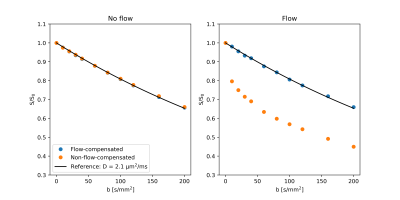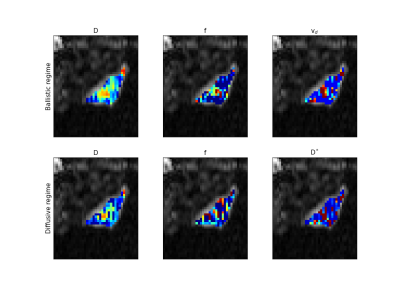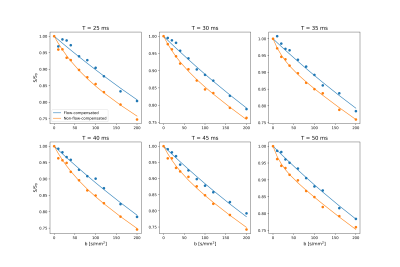2841
Time dependence of flow compensated intravoxel incoherent motion in tumor1Department of Radiation Physics, University of Gothenburg, Gothenburg, Sweden, 2Department of Medical Physics and Biomedical Engineering, Sahlgrenska University Hospital, Gothenburg, Sweden
Synopsis
This study provides initial results on the encoding-time dependence of IVIM parameters in tumor obtained from a combination of flow-compensated and non-flow-compensated diffusion-encoded data. This was made possible by constructing a pulse sequence capable of performing flow-compensated diffusion encoding with variable encoding time, which was validated through phantom measurements.
Introduction
Intravoxel incoherent motion (IVIM) provides a means to probe the characteristics of microcirculation in living tissue, completely non-invasively, using diffusion-encoding gradients1. IVIM has for example shown great promise in tumor characterization2.While the conventional pulse sequence for diffusion encoding with monopolar gradients provides a high sensitivity to microcirculation, an increased specificity and robustness can be achieved using flow-compensated gradients for diffusion encoding3,4. Depending on the blood velocity, capillary architecture and diffusion-encoding time, the signal attenuation in the capillary compartment due to flow-compensated diffusion encoding will span from no to complete attenuation. The former case is referred to as the ballistic regime, where the encoding time is such short that the blood flow does not change direction during the diffusion encoding. The latter case reflects the other extreme where the encoding time is long enough for the blood flow to change direction many times during the diffusion encoding. The encoding-time dependence may thus provide additional information about the capillary architecture, previously unavailable in vivo, which could be of interest for e.g. studies of tumor vascularization, angiogenesis and vasculature targeted therapeutics.
The aim of this project was to establish a pulse sequence capable of performing flow-compensated diffusion encoding with variable encoding time, and to use it to study the encoding-time dependence of IVIM parameters in tumor.
Methods
Pulse sequenceExperiments were performed on a Bruker 7T MR system for small animals with 400-mT/m gradients. A pulsed gradient spin-echo (PGSE) sequence with EPI readout was reprogrammed to provide a pulse sequence with bipolar diffusion-encoding gradients on either side of the refocusing pulse with the possibility to enable/disable flow compensation by changing the sign of the second bipolar gradient. An adjustable separation between the two bipolar gradients was used to enable variable encoding time (T), while keeping the echo time constant (Fig. 1).
Common imaging parameters for all experiments were TE=60ms, TR=3000ms, three diffusion-encoding directions, T=25,30,35,40,45,50ms, and b=0,10,20,30,40,60,80,100,120,160,200s/mm2. The duration ($$$\delta$$$) and separation ($$$\Delta$$$) of each gradient pulse in the bipolar gradients were 4.0ms and 4.23ms, respectively.
Phantom measurements
To validate the pulse sequence, a phantom consisting of a water-filled syringe and a pipe with flowing water was constructed. The pipe was designed to achieve a laminar flow profile in the tranversal imaging plane in the magnet isocenter with a nominal flow of approximately 7cm/s. Images of a single slice (voxel size 0.5$$$\times$$$0.5$$$\times$$$5.0mm3) were acquired with the proposed pulse sequence with flow compensation enabled and disabled. For reference, data was also acquired with a PGSE sequence (b=0,100,200,400,600,800,1000s/mm2) with the water flow turned off.
In vivo measurements
To study the encoding-time dependence of IVIM parameters in tumor, IVIM data of human medullary thyroid cancer (GOT2)5 grown subcutaneously in a balb/C mouse was acquired from nine slices (voxel size 0.4$$$\times$$$0.4$$$\times$$$0.5mm3) using the imaging parameters described above. The study was approved by the Gothenburg ethical committee on animal research.
Signal representations corresponding to the ballistic and diffusive regimes were fitted to data voxel-by-voxel for each encoding time to generate parameter maps over the tumor. The signal representation for the ballistic regime was:$$S/S_0=(1-f)e^{-bD}+fe^{-v_d^2c^2/2}e^{-bD_b}$$where S/S0 is the normalized signal, b is the diffusion weighting factor, c is the flow weighting factor1,4, f is the perfusion fraction, D is the diffusion coefficient, vd is the velocity dispersion and Db=1.75µm2/ms is the diffusion coefficient of blood. The signal representation for the diffusive regime was:$$S/S_0=(1-f)e^{-bD}+fe^{-bD^*}$$where D* is the pseudodiffusion coefficient.
For further analysis, the signal was averaged over voxels where assuming the ballistic regime provided a better fit to data (higher R2) than assuming the diffusive regime, using data from the shortest encoding time (T=25 ms). The rationale behind this is that only these voxels were assumed to possibly show an encoding-time dependence, given that other voxels already are in the diffusive regime. To study the encoding-time dependence, the IVIM parameters related to the ballistic regime were estimated from the averaged data for each encoding time.
Results
Phantom measurementsThe signal attenuation in the phantoms followed the expected behavior (Fig. 2). In the syringe, where diffusion is the only source of motion, the signal attenuation was independent of flow compensation and followed the reference data. In the pipe, on the other hand, the signal attenuation was more rapid for the non-flow-compensated data due to flow, while the flow-compensated data followed the reference.
In vivo measurements
The parameter maps were similar for the two regimes, but somewhat noisier for the diffusive regime (Fig. 3).
A distinct difference between flow-compensated and non-flow-compensated data could be seen in the average signal (Fig. 4). The signal attenuation was well described by the signal representation related to the ballistic regime for all encoding times. However, when inspecting the parameter values as encoding time increases, some trends could be seen (Fig. 5).
Discussion
As encoding time increases, the ability to explain data based on the assumption of the ballistic regime decreases. This can potentially explain the trends of increasing D and decreasing f. Additional data is needed to verify these trends. Quantifying the encoding-time dependence is also of future interest3.Conclusion
An encoding-time dependence of IVIM parameters in tumor could be seen using a combination of flow-compensated and non-flow-compensated diffusions-encoding.Acknowledgements
This study was supported by research grants from the Swedish Cancer Society, the King Gustaf V Jubilee Clinic Cancer Research Foundation, the Sahlgrenska University Hospitals Research Foundations and the Swedish state under the agreement between the Swedish government and the country councils, the ALF-agreement.
References
1. Le Bihan D, Breton E, Lallemand D, Aubin M-L, Vignaud J, Laval-Jeantet M. Separation of Diffusion and Perfusion in Intravoxel Incoherent Motion MR Imaging. Radiology. 1988;168(2):497-505.
2. Iima M. Perfusion-driven Intravoxel Incoherent Motion (IVIM) MRI in Oncology: Applications, Challenges, and Future Trends. Magn Reson Med Sci. Published online 2020. doi:10.2463/mrms.rev.2019-0124
3. Wetscherek A, Stieltjes B, Laun FB. Flow-compensated intravoxel incoherent motion diffusion imaging. Magn Reson Med. 2015;74(2):410-419. doi:10.1002/mrm.25410
4. Ahlgren A, Knutsson L, Wirestam R, et al. Quantification of microcirculatory parameters by joint analysis of flow-compensated and non-flow-compensated intravoxel incoherent motion (IVIM) data. NMR Biomed. 2016;29(5):640-649. doi:10.1002/nbm.3505
5. Johanson V, Ahlman H, Bernhardt P, et al. A transplantable human medullary thyroid carcinoma as a model for RET tyrosine kinase-driven tumorigenesis. Endocr Relat Cancer. 2007;14(2):433-444. doi:10.1677/ERC-06-0033
Figures




